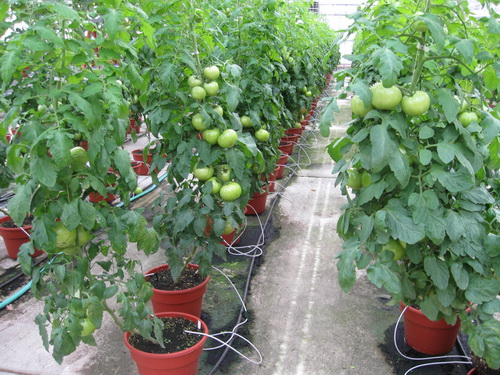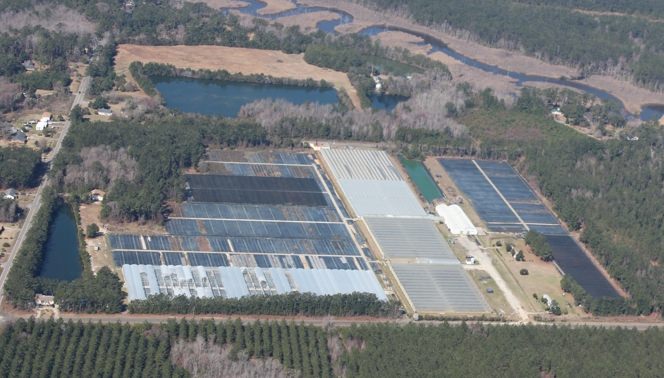Greenhouse Herb and Vegetable Production – Part 1/4 - Location


In this four-part series, we will look at the ideal location, structures and environment needed to grow vegetables and herbs in a greenhouse production facility. In this first part, we will discuss the first step: finding the ideal location to start a greenhouse production facility.
The focus will be on starting a greenhouse production facility from the ground up, but this also applies to an existing facility that produces floriculture crops.

Fitting the plant needs
Greenhouse agriculture is becoming a popular method to grow herbs and vegetables because the inside environment can be managed to fit plant needs. The greenhouse can be located on non-productive land if soilless culture is used. Moreover, plant production can be year-round and it is possible to have control over weeds, pests and diseases.
Simultaneously, energy, space, time, water and nutrients can be maximized in the greenhouse to produce high quality fruits and plants, achieving their maximum genetic potential. In order to do this, it is necessary to take into account the plant species and varieties grown (fruits, leaves, flowers, etc.), time from seed to harvest, proximity of potential customers, price fluctuations, market demand, return on investment and others, which are going to be discussed in this four-part series.
Having the best greenhouse structures, unlimited resources and the latest equipment does not guarantee maximum plant quality and yield; however, it can be obtained through trained and experienced managers (in intensive plant production, engineering and computer control) to manage employees and address the needs of the plants at the same time.
Greenhouse agriculture is an intensive method of growing since plants grow 24/7. There is little place for failure; therefore, reliable employees are indispensable within your operation.
Location
This is one of the most important considerations when planning to build a greenhouse for vegetable and herb production or growing them in your own facilities when the space is available. Factors to be considered are:
Light throughout the year
Most plants require a specific quantity of accumulated light energy to produce growth and trigger flowering. Measured as the daily light integral (DLI), it provides the quantity of light energy accumulated per day. This is influenced by the geographical location and the time of year. For example, the average DLI during December is 12 mol•m-2•day-1 in Maine and 23 mol•m-2•day-1 in Southern Arizona, whereas the DLI in June is 43 mol•m-2•day-1 in Maine and 60 mol•m-2•day-1 in Southern Arizona. The higher the quantity of light per day, the faster the plant will grow and produce fruit. Tomatoes, for example, require about 1,000 mol•m-2 of accumulated light in order to start flowering.
Relative humidity
A greenhouse can be cooled by adding water to dry air; therefore, it is desirable to build a greenhouse where the air during summer is dry to help with cooling and reduce foliar diseases.
Temperature
This parameter can be controlled to reach the optimum plant growth and development. It is desirable to have a greenhouse located in a mild climate since heating during the winter and cooling during the summer will require less energy.
Winds
The greenhouse has to be built to withstand winds that are typical for the location; its effects can be minimized by installing physical barriers (fences) or windbreakers such as trees.
Elevation
It has a great impact on air temperature during the year; high elevations are preferred.
Water
The elements in the water should be within optimum ranges, including alkalinity and total dissolved salts, and free of chemical pollution. Water supply should be sufficient to handle peak demands during hot summer days. For example, in the summer, tomatoes require 3-4 quarts of water per plant per day. In addition, water can be used to cool the greenhouse. The volume of water for cooling can be as high as the water used for irrigation.
Transportation
It is preferable to be close to paved roads or railroads because dirt roads are not smooth and cause fruits or flowers to shake, diminishing their quality. Also, close proximity to major highways will help get produce to market faster and at a lower cost.
Market
Nowadays, consumers are changing their mentality and are buying “locally grown” products because of the positive effects on the community, reduced carbon footprint from shorter transportation distances, and freshness of the products. However, there are some big vegetable greenhouse producers that expand their production facilities every year. These are two different business models that have to be considered. Other important aspects are: the window to get the maximum profit during the year, knowing the needs of customers, and the market where the product is going to be sold.
Labor
In order to take full advantage of the greenhouse, it is necessary to produce year-round. Workers have to work as a team seven days a week and sometimes they are expected to work overtime during the peak season. Workers have to know or learn different aspects of plant development and production. For example, four workers per acre are required to produce greenhouse tomatoes.
Utilities
Electricity, natural gas (or other fuel sources for heat) and phone service have to be easily accessible Electricity is essential as the majority of equipment runs on electricity, and natural gas, propane, heating oil, etc. are used as a heating source. Heating fuel choices will allow you to determine which fuel is the most economical to use.
Topography
It is more difficult to work in a greenhouse with slopes because the workers get tired more easily, bigger pumps may be required to move irrigation water uphill, plants can get uneven volumes of water and there can be spots where leached irrigation water can accumulate on greenhouse floors. Moreover, it is best to build on soil that has a good drainage capacity so water can quickly leach away.
Future expansion
Successful greenhouse companies like to expand their facilities by adding on greenhouse space. Therefore, look for a location where future expansion is possible. It is easier and cheaper to add another greenhouse than to build a new one in a new location. For example, some equipment and labor can be shared within newly expanded greenhouse ranges if they are connected. However, a second location may require investment in duplicate equipment and labor.

So, whether you choose to start a greenhouse operation or decide to grow vegetables and herbs in an existing one, the location is important. Once the location has been decided upon, the next step is to lay out and design the greenhouse. In part 2, we will discuss the factors that go into building a greenhouse production facility.